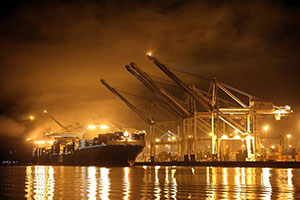The (San Jose) Mercury News
Oakland Port Sets Transition Plan After Terminal Operator's Bankruptcy

The Port of Oakland on Feb. 10 announced a plan to shift cargo away from terminals now being handled by a bankrupt terminal operator, saying it will pay up to $1.5 million to financially bolster operators being asked to handle the extra containers.
Ships that use Outer Harbor Terminal, which recently filed for a Chapter 11 bankruptcy, will instead be berthed at adjacent terminals. Most ships and cargo from Outer Harbor Terminal will relocate to Oakland International Container Terminal in the port's middle harbor. The rest go to another terminal in the outer harbor, TraPac.
The Oakland port was forced to steer to alternative berthing plans and terminals after Outer Harbor Terminal, saying it couldn't renegotiate its lease with the port and had been suffering losses in recent years, first said it would soon depart the East Bay cargo hub and soon after filed for bankruptcy to reorganize its finances.
"We have three objectives with this plan," port Executive Director Christopher Lytle said. "We will find a home for all ships that come to Oakland, we will improve cargo-handling processes to move cargo efficiently, and we'll meet the needs of shippers in Oakland."
The port, though has been left with a big hole in its finances. The Outer Harbor Terminal joint venture, which consisted of Ports America and Terminal Investment, was paying about $3 million a month in rent. The rentals from the joint venture amounted to 24% of the maritime operating revenue at the port, according to spokesman Michael Zampa.
Separately, the port said it is in the final stages of a deal whereby TraPac, a major terminal operator, would lease two additional berths at Outer Harbor Terminal.
The $1.5 million would help terminal operators open gates at night and on weekends for truckers that are picking up or dropping off containers.
The bankrupt terminal operator has $350 million in total assets and $380 million in debts, according to a filing with the court by Heather Stack, chief financial officer of Outer Harbor Terminal.
Outer Harbor Terminal accounted for 24% of the East Bay cargo hub's maritime operating revenue of $158.7 million for fiscal 2015 that ended June 30, according to Zampa. That would equate to about $38 million.
The terminal operator told the court that heavy losses in recent years, pressure to be a competitive operator at the Oakland port and an inability to restructure its lease agreement with the port combined to force it into a corner.
In addition, a suit by the company against the city of Oakland, California, over taxation issues and having to defend itself in an unfair-labor dispute brought by the National Labor Relations Board on behalf of the machinists union produced a perfect storm that led the company to seek the safe harbor of bankruptcy protection.
"In 2015, Outer Harbor Terminal began to explore potential financing alternatives that would allow it to fund long-term capital investments that would be necessary to remain competitive in its industry and, in particular, at the Port of Oakland," the bankrupt terminal operator stated in the filing. "Those efforts, however, did not prove successful."
Next, the bankrupt terminal sought to restructure its lease with the Oakland port, but six months of talks were fruitless.
Outer Harbor Terminal made its January rent payment but missed the February payment.
The port acknowledged that its first-ever long-term program for night and weekend gates will be crucial to its quest to navigate out of the current maelstrom of difficulties.
"The terminals can't move all of this additional cargo between 8 a.m. and 5 p.m.," Lytle said. "We need a smooth, seamless transition from Outer Harbor Terminal, and weekend and night gates will make a huge difference."

